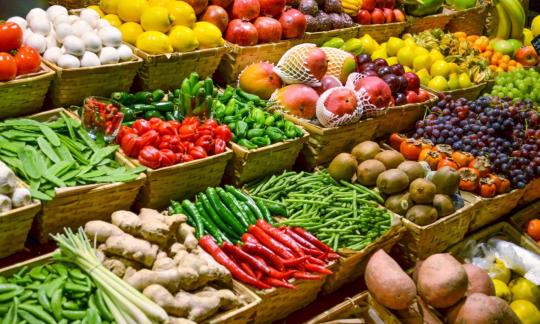Overview: Secondary plant substances - phytochemicals
Secondary plant substances are currently in focus - and that's a good thing! Discover in our overview text how you can improve your well-being and why a colorful diet is much more than just a feast for the eyes.
- These natural compounds support our immune system, promote intestinal health and protect against cancer.
- Prefer organic products: they often contain more polyphenols and carotenoids than conventional foods.
Secondary plant substances contain a lot of healthy vitality. Their best source is a varied and colorful plant-based diet with the freshest ingredients possible, also known as 'Eat the Rainbow'. This healthy nutritional diversity not only supports the intestinal flora and immune system, but also protects against cancer and other diseases.
Our brief presentation shows you how these natural substances benefit not only the plants themselves, but also us humans. We cover more in-depth explanations and chemical details in the detailed blog post Secondary Plant Substances - Phytochemicals. You will also find additional sources there.
1. Definition and basics
Secondary plant substances (SP) are found in all plants and give them color, scent and taste, among other things. This gives them a decisive advantage in survival. SP is distinguished by its name from primary plant substances such as carbohydrates, proteins, fats and micronutrients. Primary substances are essential for the energy metabolism of plants and humans, 2,3,4 while secondary substances or secondary metabolites are mainly responsible for the survival of a plant species. 1,2,4,6,13,14
However, recent publications often emphasize that these rigid distinctions are outdated. Because SPs are more multifunctional than previously assumed, the boundaries between primary and secondary metabolism are becoming increasingly blurred. 2,3,4,14
For us humans, the positive effects are clearly in the foreground when consumed in normal quantities. Numerous SPs play an essential role, particularly in the defense against diseases and for the microbiome in the human intestine. However, certain SPs can also have toxic functions in nature, e.g. to protect the plant from predators. Therefore, their effect on us humans depends heavily on the dosage and the natural interaction with other plant ingredients. 6,16
The health value of a food is often based on the combination of different SPs and their plant ingredients, which only have a special effect when combined (see below under: Occurrence in foods).
Nowadays, it is not easy to obtain objective knowledge about a natural diet. Industry and relevant public institutions provide little to no information, perhaps because economic interests are too much in the foreground. We want to change this: In our 600 or so food descriptions (ingredients for the recipes), we therefore also highlight the effects of SP wherever possible.
Functions for plants
Among the numerous functions of plant secondary metabolites, two stand out in particular: the role as a protective or defense mechanism and the role as an attractant. 1,2,4
Many SPs are known for their antibiotic, antifungal and antiviral effects. They protect plants from external threats such as pathogenic microorganisms. Others deter herbivorous insects through signal colors, a repulsive smell or taste - usually in combination with toxic plant components. Some secondary metabolites protect plants from UV radiation, oxygen radicals and promote growth regulation.
As scents or colors, SPs attract animals such as insects and birds to pollinate or spread seeds. Often, certain SPs (or groups of plant substances) or combinations thereof are characteristic of individual plant species. 2,3,4,6,14
Benefits for us humans
Since the early history of mankind, natural medicine has used the effectiveness of SP in foods, spices, extracts, medicines, incense and dyes. 5
Modern research has so far identified around 100,000 different substances among plant secondary metabolites, although the number of plants analyzed remains relatively small. 5,11
Scientists describe their spectrum of effects on the human body as diverse and name the following effects, among others: anti-cancer or anti-carcinogenic/anti-tumor, antimicrobial, antioxidant, antithrombotic, immunomodulatory, anti-inflammatory, blood pressure regulating, cholesterol lowering and digestive. The number of SPs with anti-cancer effects is strikingly high. Evidence of these effects comes from various observational studies in in vitro tests and animal experiments. 4,5,10,11
Secondary plant substances work through the amounts consumed with the usual diet. Taking a substance alone in the form of food supplements is problematic, as too high doses can have negative consequences. 16 We cover further details and tips for everyday life in chapters 3 and 4.
What does “Eat the Rainbow” mean?
This suggestion for a healthy diet is based on the following principle: We achieve a balanced diet by enjoying as much of the color spectrum of natural plant foods as possible.
In fact, the colors of many plant-based foods are related to their content of a certain secondary nutrient; thus, a change in color automatically brings with it a change in the ingredients. But that is just the proverbial icing on the cake.
Ultimately, it is primarily the natural synergies of the ingredients in unprocessed plant-based food that are useful to us. The colorful rainbow is therefore to be understood as a symbol and should include a seasonal, regionally oriented menu as well as gentle preparation methods.
2. Classification of secondary plant substances
Various parts of plants such as seeds, flowers, fruits, leaves, stems, bark, rhizomes and roots contain SP in relatively small amounts. Occurrence and composition vary depending on the plant species, stage of development and environmental conditions. Various substances result in a wide range of closely related structures. Compounds with similar structural principles often take on different biological functions. 4
Due to the wide variety of structural variations, different classification options can be found in the literature, either according to physiological or chemical aspects. For a scientifically supported basic overview 4,10,15 we suggest the following classification into main substance groups:
Main substance groups
- Isoprenoids: Monoterpenes and monoterpenoids (essential oils, iridoids), sesquiterpenes and sesquiterpenoids (germacranolides, guajanolides), diterpenes and diterpenoids (ginkgolides), triterpenes and triterpenoids (steroids, saponins), tetraterpenes and tetraterpenoids ( carotenoids)
Alkaloids: Pyridines, Tropanes, Pyrrolizidines, Indoles, Quinolines, Phenethylamine Alkaloids, Phenyl Alkaloids
Polyphenols: phenolic acids (hydroxybenzoic acids and hydroxycinnamic acids), flavonoids (flavonols, flavanols, anthocyanins, flavones, flavanones, flavanonols and isoflavones), coumestans, catechols, lignans, stilbenes, tannins, xanthones and glycosides
Organic sulphur-containing compounds: including mustard oil glycosides, sulphides
Other nitrogen-containing compounds: biogenic amines, betalains, cyanogenic glycosides
Other organic compounds: phenylpropanoids, coumarins, lactones (phthalides), quinones, aldehydes, alcohols, esters, ketones, alkanes, hydroxycarboxylic acids
Protease inhibitors: phytic acid, chlorophyll, lectins
Examples of typical ingredients can be found below in Chapter 5. Detailed explanations of the above-mentioned groups of substances and individual representatives can be found in our blog post Secondary plant substances - phytochemicals.
3. Occurrence in food
Because plant-based foods always contain a combination of several SPs and also work in conjunction with various nutrients, this natural mix is proven to be healthier than the sum of its individual components.
Many research publications provide lists of existing SPs for individual foods or lists of typical foods that are characterized by one or more secondary substances. However, this distracts from an overall perspective that is indispensable for everyday nutrition. We have therefore moved the list of example ingredients for individual main substance groups or specific SPs to Chapter 5 - and consider them as additional information (see: Useful information).
Our tips for optimal SP care are:
- Use the greatest possible seasonal variety of vegetables, fruit, nuts, seeds, grains and pulses as well as medicinal and aromatic plants. This way you can benefit from the full potential of the SP.
- Prefer a natural diet that interferes as little as possible with the natural composition of the SP. This means: eat plant-based foods as raw and unprocessed as possible or prepare them in a gentle way. In Chapter 5, we have placed tips on reducing potentially toxic substances by cooking, pickling or sprouting in square brackets.
- Secondary plant substances are often found in higher concentrations in the outer layers. So always peel vegetables and fruit carefully.
- Buy organic produce: Some publications point out that the polyphenol and carotenoid content of organically grown vegetables tends to be higher than that of conventionally grown or hydroponically grown vegetables. 17,18 Further research on this topic is needed and desirable. In addition, the peel of organically grown foods is also less contaminated with pesticides.
Bioavailability
Bioavailability indicates how quickly and how well we absorb a nutrient or a secondary plant substance in the body - and how well it can work. In the case of SP, this depends heavily on the composition of the plant-based food and the method of preparation. It is important to make a conscious selection with a focus on the degree of ripeness, origin (wild forms, old varieties), seasonality and minimal or gentle processing. 6,7
The interaction of different components of a food is crucial for a positive effect, as a large number of biochemical processes also take place simultaneously in the human body. Scientific studies show that the simultaneous intake of quercetin (e.g. from chives or berries) and vitamin C from citrus fruits increases the antioxidant activity in the body. The combination of curcumin (turmeric) with piperine (black pepper) has been proven to increase the bioavailability of curcumin. Together, these substances increase the anti-inflammatory properties. 16
Conversely, phytic acid is primarily known for inhibiting the bioavailability of minerals. Iron, zinc, calcium, copper and magnesium are primarily affected. Soaking, grinding, cooking, sprouting, fermenting and thoroughly chewing foods reduce this negative effect. However, recent research also highlights numerous benefits. 19,20,21 Read more about this in our article on phytic acid.
Carotenoids are fat-soluble plant pigments. Various factors such as variety, stage of ripeness, handling after harvest and processing have a strong influence on the content. Different parts of the same plant can also contain different types and amounts of carotenoids: for example, the skin of fruits is generally richer in carotenoids than the flesh. 4 In general, their bioavailability in raw foods is considered to be rather low. 3,4,6
- This means that careful preparation or certain types of consumption can significantly increase the absorption of carotenoids.
- It has been proven that factors such as chopping, cooking or adding fat increase their accessibility and thus their absorption. Chopping plays the biggest role here (e.g. chewing well, grating or mixing).
- Our tips for optimal carotenoid intake and sources can be found in the nutrient article on carotenoids.
Storage and preparation losses
As mentioned above, the outer layers of fruit, vegetables, grains, nuts and seeds often contain more SP than the rest of the food. To prevent valuable substances from ending up in green waste, we should eat the peel or skin wherever possible.
Storage and preparation losses have been most thoroughly researched for the group of polyphenols, but the studies do not cover the entire spectrum. The cooking process can have a major effect: onions and tomatoes lose between 75% and 80% of their original quercetin content when boiled for 15 minutes, 65% when cooked in the microwave and 30% when deep-fried. Steaming vegetables, which avoids leaching, is more beneficial.
Potatoes contain up to 19 mg of chlorogenic acid per 100 g, mainly in the skin. Large losses occur during cooking. There are no phenolic acids in French fries or freeze-dried mashed potatoes.
While the storage of apples has little effect on the phytochemical composition of the fruit, processing can have a strong influence on it. You can find out more about the ingredient apple, raw, with peel.
Similarly, industrial food processing by peeling and chopping fruit (jam, compote), legume seeds and cereals negatively affects the polyphenol content. Clarification or stabilization steps remove flavonoids, which are responsible for discoloration and cloudiness. Produced fruit juices therefore have a low flavonoid content. The pectinolytic enzymes used in this processing also hydrolyze the esters of hydroxycinnamic acid. Conversely, maceration processes facilitate the diffusion of polyphenols in the juice, as is the case when pressing red wine. This maceration contributes to the polyphenol content of red wines being ten times higher than that of white wines and also higher than that of grape juice. 17,22
Depending on the SP category, roasting processes have very different effects, which are better or worse documented depending on the research situation. We generally advise against roasting food at high temperatures because this damages heat-sensitive substances and the Maillard reaction leads to the formation of harmful acrylamide. The ingredient pistachios, roasted, for example, provides information about this.
4. Effects and benefits for health
According to epidemiological studies, a high intake of fruits and vegetables with high SP significantly reduces the risk of diseases of civilization. 18 We provide an overview of the diverse spectrum of effects of secondary plant substances above (see chapter: Benefits for us humans).
Precisely because secondary metabolites mainly act in a natural combination, it is not sensible to focus on a single substance (see above: Occurrence in food). Nevertheless, it is possible to identify foods that are particularly anti-cancer, highly digestive or cardiovascular-friendly.
Certain SPs selectively promote the growth of certain bacteria in the intestinal flora, which is why they are often referred to as "prebiotics". 10,12
- Foods rich in apigenin include parsley and celery, but also onions, coriander and chamomile.
- Flavanones in citrus fruits help the intestinal flora by both suppressing harmful microbes and activating beneficial microbes. 10 Grapefruits and oranges are particularly rich in these substances.
- Among the flavonols, quercetin has attracted research interest. 12 studies confirm the positive effects of foods that contain a lot of quercetin, such as berries, apples and kale. 10
- Curcumin in the turmeric root is considered a good regulator of the intestinal microbiome.
- Lignans promise to improve the microflora in the intestine. Flaxseeds are the top lignans with 8.17.
- Carotenoids also have positive effects by promoting beneficial intestinal bacteria. Examples include black currants, tomatoes and watermelons.
A striking number of SPs have anti-cancer effects. The research literature provides good information on effects against certain types of cancer. 23
- It is well documented, for example, that β-carotene reduces the risk of lung, prostate, esophageal, cervical, stomach and colon cancer (e.g. from carrots, pumpkin, cabbage, spinach; see: Carotenoids).
- Saponins are said to have an effect against colon cancer 23 (e.g. from legumes, eggplant or fennel).
- Phenolic compounds such as curcumin influence the cell cycle and inhibit the growth of malignant tumors, such as skin tumors 24,22 (e.g. from curcuma).
- Flaxseeds show a significant protective effect against breast cancer, thanks in part to their lignans 8 (see Flaxseeds, raw, organic?).
- Avocados are said to have the potential to reduce the risk of benign prostatic hyperplasia because they contain a lot ofbeta-sitosterol (see there).
- Apples, as a unique combination of nutrients, protect against or in the case of cancer of the oral cavity and throat, esophageal cancer, colon cancer, laryngeal cancer, breast cancer, ovarian cancer and prostate cancer (see ingredient apple, raw, with peel).
Phenolic compounds in nuts are particularly beneficial for cardiovascular health. 25 We mainly recommend nuts with a favorable LA-ALA ratio, i.e. walnuts and macadamia nuts, of course also in combination with other nuts and seeds.
A wonderful example of the variety of effects of a natural food is the apple. Its beneficial effects on the stomach and intestines are not limited to the high quercetin content, but also come from the pectins. SP in apples are also important antioxidants and inhibit the growth of cancer cells, have a positive effect on blood lipid levels (cholesterol levels) and protect LDL cholesterol from oxidation, among other things. There are also various advantages such as protecting the gastrointestinal tract from the effects of medication, good weight management, effects against osteoporosis, maintaining lung function and reducing the risk of diabetes (see ingredient apple, raw, with peel).
5. Things to know
For interested readers, the following Click For contains selected examples of typical foods that are rich in a certain secondary substance/group of substances. The plant ingredients are arranged according to the main substance groups defined above (see Chapter 2: Classification of secondary plant substances). You can also find information and additional sources on this in the blog post Secondary plant substances - phytochemicals.
Typical foods, sorted by main substance groups
Isoprenoids:
- Terpenes and terpenoids 5,9 are found in many spices and medicinal plants and characterize the aroma of citrus fruits and parts of conifers, for example. Essential oils consist mainly of terpenes and terpenoids.
- Thyme, sage, oregano, marjoram, savory, rosemary, tarragon
- Cypress, birch leaves
- Lemongrass, ginger, coriander
- Ceylon cinnamon, black pepper, fennel seeds
- Chamomile, peppermint, lemon balm
- Garlic, chives, nasturtium
- Clementines, limes, oranges
- Walnuts, hemp seeds, pine nuts, pistachios, almonds, peanuts
- Beta-sitosterol is a phytosterol that has been researched particularly in plant oils. Natural sources: Avocados are considered good sources, as are rapeseed oil, various nuts and fresh vegetables (see Beta-sitosterol).
- Carotenoids are an important group of tetraterpenes. 11 They are responsible for the yellow, orange and red colouring in fruit and vegetables, but are also found in green vegetables, herbs and cereals.
- Herbs such as parsley, basil, coriander, dill and chervil are rich in carotenoids.
- β-Carotene is characteristic and color-determining for carrots and sweet potatoes, but is also abundant in spinach.
- Lycopene is dominant in tomatoes (dried and raw), guava, watermelon, papaya and grapefruit, as well as in some medicinal herbs such as rose hips, orange marigolds, fireweed and porcini mushrooms.
- Lutein and zeaxanthin are present in large amounts in goji berries, dandelions, nettles, nasturtiums, marigold, kale, radicchio, spinach, chard, red algae and garden cress. Lutein is the most dominant carotenoid in most wheat varieties.
Alkaloids: Well-known alkaloids include caffeine, theobromine and solanine.
- Caffeine is found in plants such as coffee, tea, cocoa and guarana.
- Theobromine is the most important alkaloid in coffee, tea and cocoa or chocolate.
- The toxic solanine also belongs here (e.g. in potatoes [reduce by cooking!]).
- The same goes for piperine, which is responsible for the spicy taste of pepper.
Polyphenols: Polyphenols occur in high concentrations, including as colorants, flavorings and tannins. Quercetin is found in almost all plants and their products, while other substances are characteristic of certain foods. 17
- Quercetin is found in capers, onions and chives, for example; berries, apples and kale are the richest in it. 10
- Apples mainly contain phenolic acids and flavonoids. 18
- Walnuts and pecans in particular, but also macadamia nuts, are considered good sources of flavonoids. 25
- Citrus fruits contain a lot of flavanones. 17
- Soybeans are particularly rich in isoflavones.
- Blueberries are a good source of caffeic acid (a hydroxycinnamic acid) 9 as well as anthocyanins.
- Anthocyanins color plant parts pink, red, blue or purple, e.g. eggplants, red grapes, rhubarb, blackberries, cherries, strawberries and the aforementioned blueberries.
- Curcumin is the main coloring component of turmeric (Curcuma).
- Flaxseeds are the richest source of lignans (phytoestrogens) in the plant world. 8, 17
Organic sulphur-containing compounds:
- The typical aroma of mustard, horseradish, cabbage, nasturtiums and watercress is due to the mustard oil glycosides.
- Sulfides, especially alliin, characterize the unmistakable smell of garlic, onions, chives, shallots, leeks and wild garlic.
Other nitrogen-containing compounds:
- Cyanogenic glycosides serve as a defense against herbivores and release poisonous hydrogen cyanide after tissue damage. They occur naturally in cherry laurel, elderberries and cassava [reduce by cooking!].
- Almond kernels contain little amygdalin, so they can be eaten raw.
Other organic compounds:
- These include anethole in anise oil, eugenol in cloves and vanillin (all phenylpropanoids).
- Coumarin suppliers include tonka beans, yarrow, lovage and buckwheat.
- Hydroxycarboxylic acids include malic acid (sour apples), tartaric acid (grapes, bananas, avocados), citric acid (citrus fruits) and lactic acid (asparagus beans).
Protease inhibitors:
- Phytic acid is present as an important phosphorus reservoir in the outer layers of whole grains (such as corn, wheat, barley and rye), pulses (such as soy) and oilseeds (such as pumpkin seeds). [Reduce by cooking, pickling and sprouting!]
- Chlorophyll is abundant in green fruits and vegetables and in various salads and herbs, such as spinach, kale or basil.
- Lectins are found in the seeds of many legumes (e.g. phasin in green beans or soybean agglutinins in mature soybeans and edamame). [Reduce by cooking!]
Bibliography - 25 Sources (Link to the evidence)
Many researchers do not believe that Wikipedia is an authoritative source. One reason for this is that the information about literature cited and authors is often missing or unreliable. Our pictograms for nutritional values provide also information on calories (kcal).
| 1. | Abraham L. Bioaktive sekundäre Pflanzenstoffe und ihre Wirkung in Pflanzen und Menschen. Diplomarbeit Uni Graz. 2019. |
| 2. | Erb M, Kliebenstein DJ. Plant secondary metabolites as defenses, regulators, and primary metabolites: the blurred functional trichotomy. Plant Physiol. 2020 Sep;184(1):39–52. |
| 3. | Hahn A. Lebensmittel und Ernährung. In: Matissek R, Hahn A (Ed.) Lebensmittelchemie. Berlin, Heidelberg: Springer;2023:37-91. |
| 4. | Hänsel R, Sticher O (Ed.) Pharmakognosie-Phytopharmazie. Berlin/Heidelberg: Springer-Lehrbuch; 2010. |
| 5. | Masyita A, Mustika Sari R et al. Terpenes and terpenoids as main bioactive compounds of essential oils, their roles in human health and potential application as natural food preservatives. Food Chemistry: X. 2022 Mar;13:100217 |
| 6. | Nowack, R. Pflanzliche Sekundärstoffe: Ethnobotanische Überlegungen zu ihrer Bedeutung für die menschliche Ernährung und die Medizin-Teil 1: Grundlagen der pflanzlichen Sekundärstoffe. Schweizerische Zeitschrift für Ganzheitsmedizin/Swiss Journal of Integrative Medicine, 2016,28(3):157-164. |
| 7. | Nowack, R. Pflanzliche Sekundärstoffe: Ethnobotanische Überlegungen zu ihrer Bedeutung für die menschliche Ernährung und die Medizin-Teil 2: Bedeutung der Sekundärstoffe bei der Domestikation der Nahrungspflanzen. Schweizerische Zeitschrift für Ganzheitsmedizin/Swiss Journal of Integrative Medicine, 2016,28(4):223-230. |
| 8. | Rabić R. Wirkungsbereiche der Phytohormone und Phytoöstrogene im pflanzen-und humanphysiologischen Aspekt. Diplomarbeit Uni Graz 2021. |
| 9. | Bäumler S. Arzneipflanzenporträts. 3. Auflage. München: Elsevier; 2021. 858 S. (Heilpflanzenpraxis heute / Siegfried Bäumer). |
| 10. | Santhiravel S, Bekhit AEDA, Mendis E, Jacobs JL, Dunshea FR, Rajapakse N, et al. The impact of plant phytochemicals on the gut microbiota of humans for a balanced life. Int. J. Mol. Sci. 2022;23(15):8124 |
| 11. | Stange R, Leitzmann C. Ernährung und Fasten als Therapie. Berlin/Heidelberg: Springer; 2010. |
| 12. | Wang L, Huang G et al. Multi-omics reveals the positive leverage of plant secondary metabolites on the gut microbiota in a non-model mammal. Microbiome. 2021;9(1):192. |
| 13. | Wink M. Evolution of secondary metabolites from an ecological and molecular phylogenetic perspective. Phytochemistry. 2003 Sep;64(1):3–19 |
| 14. | Wink M, Evolution of secondary plant metabolism. Encyclopedia of Life Sciences. 2016. |
| 15. | Tiwari BK, Brunton NP, Brennan CS, Herausgeber. Handbook of plant food phytochemicals: sources, stability and extraction [Internet]. 1. Aufl. Wiley; 2013 |
| 16. | Fischer AM, Kressig R. Die Bedeutung von sekundären Pflanzenstoffen. Schweizer Zeitschrift für Ernährungsmedizin. 4/2023. |
| 17. | Manach C, Scalbert A et al. Polyphenols: food sources and bioavailability. The American Journal of Clinical Nutrition. 2004;79(5):727–747. |
| 18. | Stracke B, Rüfer CE, Watzl B. Polyphenol- und Carotinoidgehalt in Äpfeln und Karotten aus ökologischem und konventionellem Anbau. Ernaehr.-Umsch. 2010;57:526–531. |
| 19. | Biesalski HK, Bischoff SC, Pirlich M, Weimann A, Herausgeber. Ernährungsmedizin: Ernährungsmedizin 5. Auflage-Thieme: Stuttgart, NewYork. 2018. |
| 20. | Pujol A, Sanchis P et al. Phytate intake, health and disease: “let thy food be thy medicine and medicine be thy food”. Antioxidants. 2023;12(1):146. |
| 21. | Samtiya M, Aluko RE, Dhewa T. Plant food anti-nutritional factors and their reduction strategies: an overview. Food Production, Processing and Nutrition. 2020;2(1):6. |
| 22. | Rahman MdM, Rahaman MdS et al. Role of phenolic compounds in human disease: current knowledge and future prospects. Molecules. 2021;27(1):233. |
| 23. | Leitzmann C. Warum sekundäre Pflanzenstoffe vor Krebs schützen können. Passion Chirurgie. 2014 Juni,4(06):Artikel 02_01. |
| 24. | Condezo-Hoyos L, Gazi C, Pérez-Jiménez J. Design of polyphenol-rich diets in clinical trials: A systematic review. Food Research International. 2021;149:110655. |
| 25. | Woźniak M, Waśkiewicz A, Ratajczak I. The content of phenolic compounds and mineral elements in edible nuts. Molecules. 2022;27(14):4326. |
This apple and thyme chocolate cake has a delicious nutty flavor and isn’t too sweet. Apple and thyme give it a fresh taste and cocoa butter only adds to this.
This basic recipe for a delicious raw vegan chocolate with lucuma powder provides an easy-to-prepare, easily expandable treat.
These vegan flour- and oil-free brownies with almond butter and walnuts are easy to make and delicious.
Cocoa powder (unsweetened) is available raw or roasted. Natural cocoa powder is usually lighter than processed powder. Organic quality?
Dark chocolate with 70-85% cocoa content is vegan and available in organic quality (organic). Whether it is really raw (drying, fermentation) is questionable.
Dark chocolate coating (couverture) with coconut oil is a cocoa-based glaze. It is easy to make yourself and is suitable for coating baked goods. Organic?









Comments